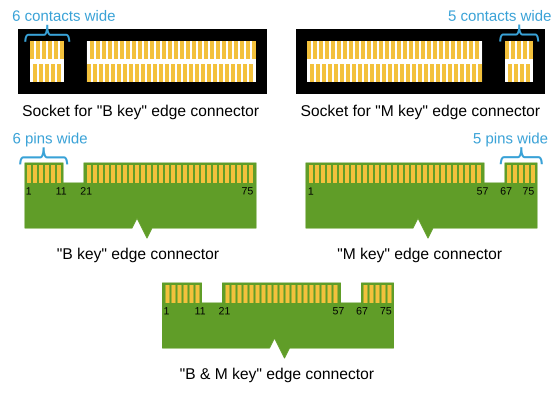Edit: It is! I got the WiFi replaced and functional.
I need a confirmation that this is an accurate diagram, I have a A+E-key WiFi adapter, and I need to use it to replace a E-key WiFi adapter. I cannot find much information about compatibility, and need some confirmation before I stick my adapter in a type-e slot.
I cannot confirm anything here, but that diagram scares the fuck out of me.
Much like a cat, if it fits, it sits.
Thank you for your answer!
You can use a A+E card on a E slot, that’s basically why they were made, to be compatible with both.
I have such setup on my desktop computer (A+E Intel AX210 in a E slot PCIe daughter board).
thank you!
A+E will work in E. It’s more on the motherboard manufacturer if it’s supported or not. Check your manual.
Thanks! Can you elaborate on what would cause it to not be supported? I know the wifi card I’m replacing is an e-key, and I’m using a laptop so I likely won’t find any information. Also, if you would happen to know what brands I should look out for that have good linux compatibility if I want to buy a newer one?
Be very wary of the staggered pins in the diagram. I don’t trust the diagram.
Thank you for your input! I can’t tell if the diagram was made poorly or if M.2 does use staggered pins.
I’m not entirely sure myself with current tech, but when we got our first external adapter for SSD drives for MacBooks, the connector was made so sloppy that you’d literally have to manually make sure it was aligned properly in the slot.
There was like half a millimeter of slop in the slot where if you inserted it incorrectly, everything would lose its magic smoke…
You seem to love spreading misinformation on the web. Why are you commenting 4 times if you are not familiar with the topic?
This is an m.2 connector. You have to secure it with a screw on the other side. It’s nearly impossible to mess it up.
Apple frequently uses proprietary connectors, I don’t know which one you are reffering to. I won’t guess because I’m not very familiar with all apple connectors.
You don’t have to comment on a topic if you are not familiar with. Please stop.
Why is the diagram incomplete? It shows both sides of the socket, but only one side of the card. Are the pins really staggered like that?
I never trust incomplete diagrams, and I’m not finding a proper diagram that shows both sides to confirm or deny anything.
It’s a strange diagram but shows what you have to know. If you ever seen different keyed m.2 cards, you should understand this. The important thing is the location of the keys, the notch. All m.2 cards has an ‘up’ and ‘down’ side, it shows only the ‘up’ side. You have to look inside the receptor to see the pins, that’s why it shows both sides, it’s not possible to see one side only on the receptor as they are in a plastic casing. Usually you can’t see the pins on the mobo, only the key.
You can see a similar diagram on wikipedia, both sides of receptor, top side of card:

The offset you were writing about doesn’t matter, it actually helps. You can’t accidentally insert the card upside down. The location of notches also help with this, as not all possible notches used yet, but in the future it could change.
These connectors are really small. The receptor is similar how sodimm connector works, but smaller. Are you also afraid about inserting a ram in an laptop? It’s basically the same.
Read more about the connector in wikipedia, I’m really happy this slowly replaces sata, msata, mpcie and even pcie in current pcs.
Did you not notice the staggered pinout on the diagram? That looks like it’s literally designed to be a short circuit no matter what the manual says.
I’ve literally dealt with staggered pin short circuits twice in my life, one from equipment damage, and another from piss poor engineering.
Either way it’ll totally fry the power supply, if not more…
I thought the staggered contacts engage with similarly staggered pins on the other side of the card?? 🤔
You are right. The user you are replying to has no idea what they write about, as they confessed in another comment.
I’m not hands on familiar with these standards, so I’m not entirely sure. But when I see a diagram showing 4 pins on one side and 3 pins on the other, but the card going into it only shows one side, then it raises immediate red flags of incomplete information.
No worries, my card has 4 on one side and 3 on the other, so I don’t believe that will be an issue. I thought that you were more concerned about the slight difference in the pin’s location from top to bottom of the slot diagram.
Cool cool. I was worried that it might be a piss poor diagram made by a 10 year old just learning Photoshop or something.
When it comes to electronic diagrams, I’m used to seeing complete pinouts that label every single pin, like ground, power, data and clock signals and whatnot.
Seeing such an incomplete diagram like this one just scares me though.
An E keyed socket should provide everything an A+E card needs to function. Plug it in and test it out. Generally with m.2 if the card fits the socket you’re good to go (just don’t expect a CNVi card to work on a non CNVi platform.)
The “key” of an m.2 defines what the pins mean, basically what signal they carry (PCIe, USB, …). There’s a nice table here, if you scroll down a bit. Some are extensions to others, and are pin compatible (meaning the things they have in common are on the same pins).
A key and E key are very similar, while E just provides a few more interfaces, but importantly A doesn’t provide anything the E doesn’t. So any card that can work in A can also work in E. This is why A+E is so common: they don’t require the Mainboard to provide E, only A, but both will work so both notches are present.






